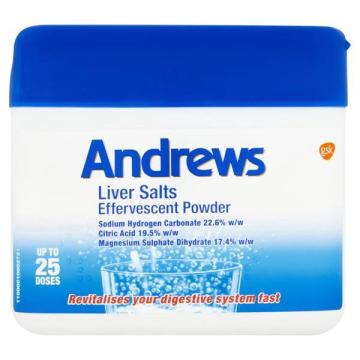
Andrews Liver Salts 150G is for the treatment of upset stomachs, indigestion and symptoms of over-indulgence. It quickly and effectively relieve an upset stomach, indigestion and symptoms of over-indulgence (over eating and drinking). Taken at a high dosage, Original Andrews Liver Salt can also relieve constipation, and is recommended as a laxative and an antacid for the relief of upset stomach, indigestion and biliousness.
Sodium bicarbonate exerts an immediate antacid effect in the stomach by neutralising acid secretion with the liberation of carbon dioxide. Citric acid and sodium bicarbonate in solution have a buffering capacity which alleviates discomfort caused by excess acidity in the stomach. Magnesium sulphate is not readily absorbed from the intestine and acts as a saline purgative. Magnesium ions in the gut have also been shown to cause secretion of cholecystokinin which favours intraluminal accumulation of water and electrolytes. Sodium bicarbonate exerts an immediate antacid effect in the stomach by neutralising acid secretion with the liberation of carbon dioxide. Citric acid and sodium bicarbonate in solution have a buffering capacity which alleviates discomfort caused by excess acidity in the stomach. Magnesium sulphate is not readily absorbed from the intestine and acts as a saline purgative. Magnesium ions in the gut have also been shown to cause secretion of cholecystokinin which favours intraluminal accumulation of water and electrolytes.
What is the digestive system?
The digestive system is made up of the gastrointestinal tract—also called the GI tract or digestive tract—and the liver, pancreas, and gallbladder. The GI tract is a series of hollow organs joined in a long, twisting tube from the mouth to the anus. The hollow organs that make up the GI tract are the mouth, esophagus, stomach, small intestine, large intestine, and anus. The liver, pancreas, and gallbladder are the solid organs of the digestive system.
The small intestine has three parts. The first part is called the duodenum. The jejunum is in the middle and the ileum is at the end. The large intestine includes the appendix, cecum, colon, and rectum. The appendix is a finger-shaped pouch attached to the cecum. The cecum is the first part of the large intestine. The colon is next. The rectum is the end of the large intestine.
Bacteria in your GI tract, also called gut flora or microbiome, help with digestion. Parts of your nervous and circulatory NIH external link systems also help. Working together, nerves, hormones, bacteria, blood, and the organs of your digestive system digest the foods and liquids you eat or drink each day.
-
Dosage
For upset stomach, indigestion and over-indulgence: Measure one level spoonful (5ml spoonful) into a glass of water and drink.For constipation: Measure two level spoonfuls (two 5ml spoonfuls) into a glass of water and drink. -
Ingredients
Active ingredients: Sodium Hydrogen Carbonate 22.6% w/w, Citric Acid 19.5% w/w and Magnesium Sulphate (Dihydrate) 17.4% w/w, Other ingredients: Sucrose 40.5% w/w, Carbohydrate content: 2g per 5ml teaspoon -
Storage Information
Do not store above 25cDo not store above 25c, away from direct sources of heat and humidity. Keep in original container
